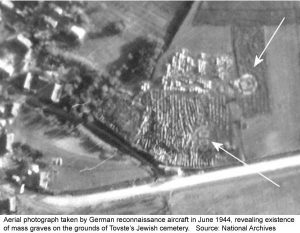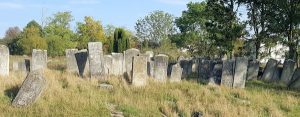![]() Ця сторінка також доступна українською.
Ця сторінка також доступна українською.
Introduction
This page summarizes and analyzes a project which documented through a review of published research and surveys, plus original research, a history of the Jewish cemetery of Tovste in the Zalischyky raion of the Ternopil oblast in western Ukraine. The cemetery information is presented in context of a growing but already extensive history of the Tovste Jewish community which had established and maintained the cemetery, and significantly, histories of the other communities (both Ukrainian and Polish) of pre-WWII multicultural Tovste. All of the historical narrative and data have been published in organized sections and pages on a permanent website for free public access. This project also incorporates information and data from projects managed by other individuals and organizations at the same site.
This page is intended as a reference for similar projects now in the planning stages in western Ukraine or beyond. Following a brief summary of the site, the material below describes the project and reviews its effectiveness together with a listing of issues encountered, approximate project costs, and ongoing risks. Related projects both in western Ukraine and elsewhere in Europe are also briefly mentioned, for comparison. At the bottom of this page are links to project documentation and to additional reference information about the burial site and related projects.
Read the overview to case studies of selected projects at Jewish burial sites in western Ukraine.
Project Summary
Project type: Digital documentation of the history of the Jewish cemetery, with an extended history of the associated Jewish community and the town.
Location and site type: Jewish cemetery of Tovste, Zalischyky raion, Ternopil oblast, Ukraine. GPS: 48.84961, 25.73207.
Description of the site: The cemetery perimeter is an irregular shape of approximately 350m length, enclosing roughly 3/4 hectare of area, on a hillside with moderate slope.
Ownership and stakeholders: The cemetery site is owned by the municipality of Tovste. Stakeholders include the local civil community, survivors and foreign descendants of Jewish families from pre-war Tovste and nearby towns and villages, historians, and students of Jewish culture.
Official heritage status: Unknown.
Activists working on/at the site: Douglas Hykle, a Canadian descendant of an ethnic Ukrainian family originally from Tovste, through his website tovste.info. Contact info.
Other projects active at the site: Digital documentation of the cemetery terrain (see case study 01); digital documentation of the surviving headstones in the cemetery (see case study 02); perimeter fencing (see ESJF 2019 project); regular vegetation clearing and maintenance (by the municipality and local goat herders); other histories of the Jewish community, including the cemetery (see the Sefer Tluste, in original Hebrew and Yiddish and in translation to English).
Project Analysis

The Luftwaffe aerial photo of the cemetery site and mass graves;
click the image to see it on the tovste.info Jewish history page.
History of the site: Research and a 1996 survey by Yuriy Isaakovich Khodorkovskiy for the US Commission (now IAJGS International Jewish Cemetery Project) indicates that the cemetery was established by the Jewish community in the 17th century; the earliest dated matzevah documented by the project is from 1678, the latest from 1942 (with a possible individual memorial from 1945). Research by Douglas Hykle for tovste.info – from numerous sources, including survivor accounts and German Luftwaffe wartime aerial photos – indicates that two to three thousand area Jews were killed and buried in pits at the cemetery site. An aerial photo from 1944 also suggests that the number of headstones in the cemetery before WWII was significantly higher than today.
Current features of/at the site: The cemetery is situated adjacent to a main road, with its entrance about 500m along that road heading east from the town center. A large municipal cemetery is adjacent to but separate from the Jewish cemetery less than 100m further east. Other sides of the Jewish cemetery are bounded by residential properties and gardens, agricultural land, and the building structures of a relatively new lumber business. Earlier surveys counted several hundred surviving matzevot within the cemetery, mostly in their original location, more than half of which were reported to have been toppled and/or broken. A memorial monument is erected near the site of two of the mass graves, close to the cemetery entrance. The cemetery has been partially enclosed with fencing for the past decades, with a new fence installed by ESJF in 2019. In the past, vegetation has been effectively controlled by the town and, until the area was completely enclosed, through grazing by local goats. Access and visibility was excellent during a 2017 visit.
Details of the project: The overall town documentation project has been underway since the first visit to Tovste in the late 1990s by Hykle, a foreign descendant of an ethnic Ukrainian family of the town. Originally an endeavor focused on pre-1900s genealogy, the research quickly broadened to embrace the entire town, and gained a web presence beginning in 2006; the investigation actively continues, with frequent trips to Tovste and to other European, North American, and Israeli locations to access archives, conduct interviews, and meet with other researchers.
After the basic US Commission / IAJGS survey of the Jewish cemetery and almost a decade before the wider JGB effort, Hykle began his own documentation effort to capture headstone photographs and translations of epitaphs of about 10% of the total number, as a study of the feasibility of conducting a comprehensive survey.
Hykle’s overall town documentation project has provided important insights about the Jewish cemetery and avenues for further research. For example, abundant witness testimony from various sources sheds light on what transpired during mass killings at the cemetery and helps to identify some of the victims buried in the mass graves. Contemporary exhumation reports offer further details. Moreover, the recent exercise to transcribe and map headstones may – with further spatial and temporal analysis – offer brand new information of value to genealogists and historians.
Issues encountered in the project: The feasibility study demonstrated that, with sufficient volunteers, it would not be a major undertaking to document this particular cemetery – owing to the fact that the grounds had been kept largely free of obstructive vegetation, and the remaining headstones were in relatively good condition. The transcription exercise revealed to Hykle that it can be easier to read inscriptions from a photographic image (processed or otherwise) than directly from the headstone itself.
A lack of communication about (and between) similar cemetery documentation projects may have caused some redundancy of effort. For example, Hykle only came to know of the JGB work several years after it was conducted in 2014 (he and JGB have since had fruitful collaboration). He later discovered by accident that the Center for Jewish Art had already documented about 150 of the same gravestones in 1991, which was also not mentioned on the JGB website.
Project costs, one-time and sustaining: The limited feasibility study to photograph and transcribe a portion of the cemetery headstones entailed mostly free volunteer time, which can be counted in days. In contrast, the cost of the much wider, ongoing town documentation project – lasting some 15 years to date, involving several tens of thousands of hours of work and considerable expense associated with travel to numerous countries – would be impossible to quantify with any degree of accuracy.
Current risks to preservation: To the physical cemetery site: none apparent, apart from ordinary weathering and hitherto uncontrolled access; the future impact (to ongoing cemetery maintenance and public perception) of fully enclosing the cemetery remains to be seen. To the data: None so long as the site author continues to support and maintain the website. Since 2008 the tovste.info website has been crawled and recorded more than 50 times, and the subsection on the Jewish cemetery at least 20 times, in the Internet Archive Wayback Machine.
Related projects in western Ukraine: Many JewishGen family history pages in the town-focus KehilaLinks database include descriptions, photographs, and histories of western Ukrainian Jewish cemeteries, and many pages with good cemetery information also include extended histories of the associated Jewish communities. Significant examples include Skala-Podilska and Okopy (Ternopil oblast), Shchyrets (Lviv oblast), and Mizhhiria (Zakatpattia oblast). However, there are no uniform standards for documentation across the KehilaLinks pages, and few of these pages also include histories of other ethnic groups in the towns for comparison and context. Several local history museums in western Ukraine also provide good information about their Jewish cemeteries, including a project by the local museum in Brody which describes all of the historical Jewish cemeteries of the city, including the surviving “new” or cholera cemetery.
Related projects outside western Ukraine: The same KehilaLinks pages described above also cover places with Jewish cemeteries throughout Europe and beyond. In the Czech Republic, the tourist office of the Jewish community of Brno (South Moravia region) has produced an online guide to over 70 Jewish cemeteries of the region, including cemetery maps plus photographs and data on many of the headstones at each site; an example is the extensive page for the cemetery in Velké Meziříčí, which is accompanied by a page describing the Jewish heritage sites in the town, including the history of the cemetery. In Germany, the Salomon Ludwig Steinheim Institute for German-Jewish History (Institut für deutsch-jüdische Geschichte) at the University of Duisburg-Essen is cataloguing Jewish headstone inscriptions at cemeteries around Germany and in former German lands in a database project called Epidat (Database of Jewish Epigraphy); an example is the Jewish cemetery of Mainz on the Rhine and Main rivers, which includes details on more than 100 inscriptions along with a well-researched history of the cemetery and re-use of its headstones over the past millennium.
References
- Tovste’s Jewish Cemetery – the cemetery documentation page by Douglas Hykle on tovste.info; see also the related page with the website’s original effort to document the cemetery’s headstones
- Memorial Book of Tluste (Tovste Ukraine) – an online English translation of Sefer Tluste, the Yizkor (memory) book for Tovste’s pre-war Jewish community, translated by Sara Mages and edited by Douglas Hykle, hosted by JewishGen on the website for their Yizkor Book Project; see also an online image set of the original Hebrew version of the book, as “Tolstoye”, hosted by the New York Public Library Digital Collections
- Tluste Cemetery – the cemetery documentation project page on the Jewish Galicia and Bukovina website
- Jewish cemetery in Tovste (Tłuste) – the 1991 cemetery photographs and documentation page in the web database of the Center for Jewish Art
- Tovste Jewish Cemetery – terrain measurements and survey notes by ESJF European Jewish Cemeteries Initiative
- Tovste – Jewish cemetery fencing project data and images by ESJF European Jewish Cemeteries Initiative
- Tolstoye – the cemetery research and survey page on the website of the IAJGS International Jewish Cemetery Project
- Tovste – brief description of the mass grave at the cemetery on the website of the IAJGS International Jewish Cemetery Project
- Tłuste Center Cadastral Map 1858 – a highly detailed historical property map of the town from a survey during the Austrian era, showing the Jewish cemetery on two land parcels and many other town features, from map panels preserved by the State Archives of the Ternopil Oblast and presented by Gesher Galicia; see also the related maps in a sketch from ca. 1826 (which shows the original cemetery land parcel), and a map fragment from 1899 (which also shows the cemetery expansion into an adjacent parcel)
- In and Around Chortkiv – a photo and text essay from 2017 covering the Tovste Jewish cemetery and other nearby sites, from Christian Herrmann’s Vanished World blog site


